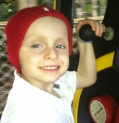Optimization of a GPC2 ADC for neuroblastoma and other pediatric cancers

Mentor: Dr. Kristopher Bosse
Neuroblastoma is a cancer that occurs in young children and is often lethal. Recent immunotherapy advances have resulted in enthusiasm for the use of this treatment in children with cancers. However, we desperately need new molecules to safely and specifically target on neuroblastomas with immunotherapy. Ideal immunotherapeutic targets should be located on the surface of tumor cells, expressed robustly on tumor cells but not on normal tissues, and play a role in helping tumors grow. We have discovered that a protein called GPC2 meets these criteria in several pediatric cancers including neuroblastoma and a subset of several pediatric brain tumors and sarcomas. We have developed a new immunotherapy, a GPC2-targeting antibody-drug conjugate (ADC), which safely delivers a potent drug to tumor cells by binding to GPC2 on the tumor cell’s surface, internalizing into the cell, and inducing damage to the tumor cell’s DNA thus causing cell death. We have shown that this ADC immunotherapy is effective in treating neuroblastoma cells and are now interested in further optimizing this drug to best engineer a drug that will be safe to give to children. Further, while we have nominated other pediatric cancers, such as high grade gliomas (HGGs), atypical teratoid rhabdoid tumors (AT/RTs), embryonal tumors of multilayered rosettes (ETMRs), Ewing sarcomas and rhabdomyosarcomas to also potentially benefit from GPC2-directed immunotherapies, further validation is required to confirm robust cell surface GPC2 expression and efficient antibody internalization. Finally, it remains unclear which drug is most optimal to conjugate to GPC2-directed antibodies to generate the most effective and safe ADC. This project will first focus on validating GPC2 cell surface expression on several pediatric brain tumor and sarcoma preclinical models and then testing a panel of ADC payloads in these cellular models and a panel of neuroblastoma cell lines. Thus, this work will possibly directly lead to a new therapy that will improve outcomes for children with neuroblastoma and potentially other GPC2-expressing pediatric solid tumors.

